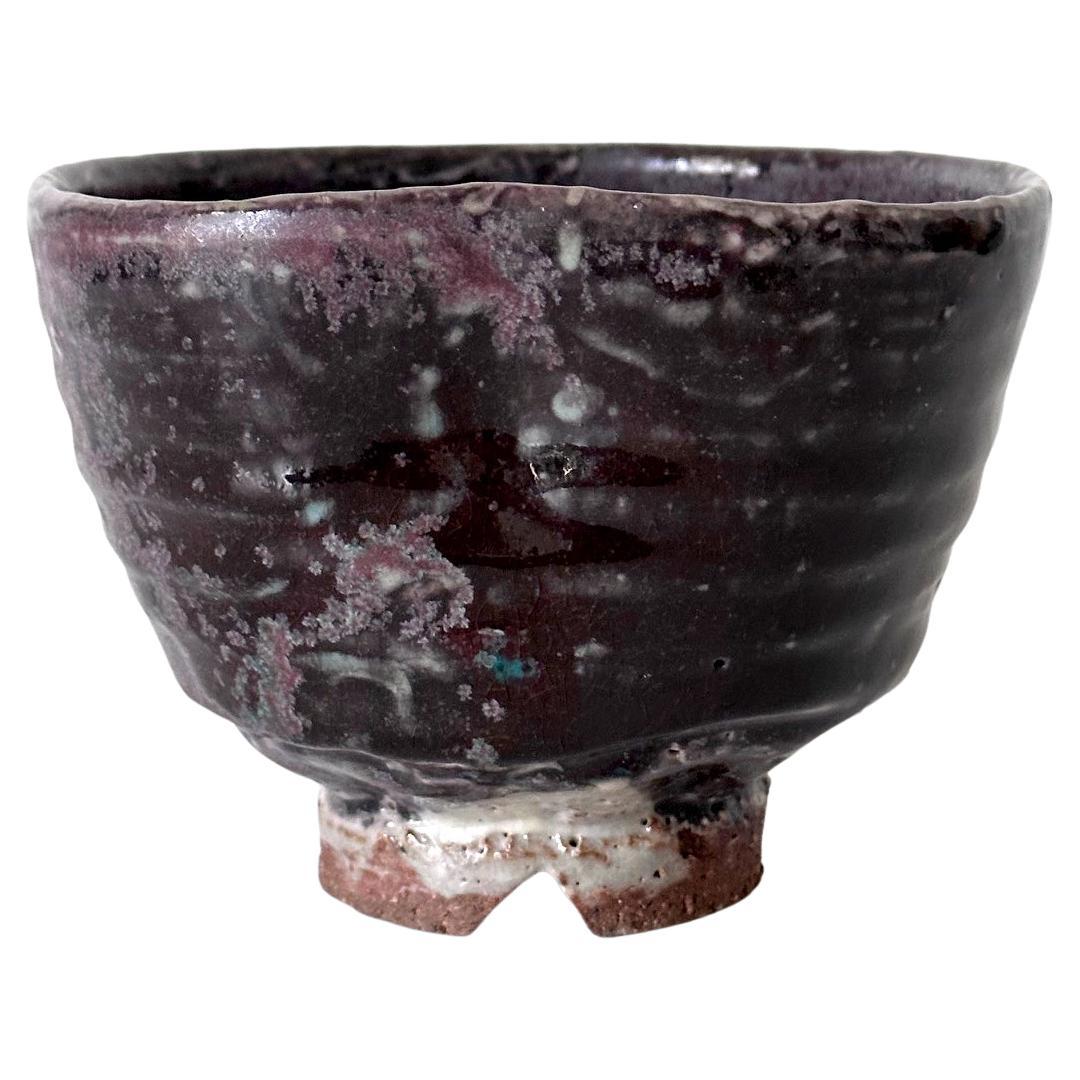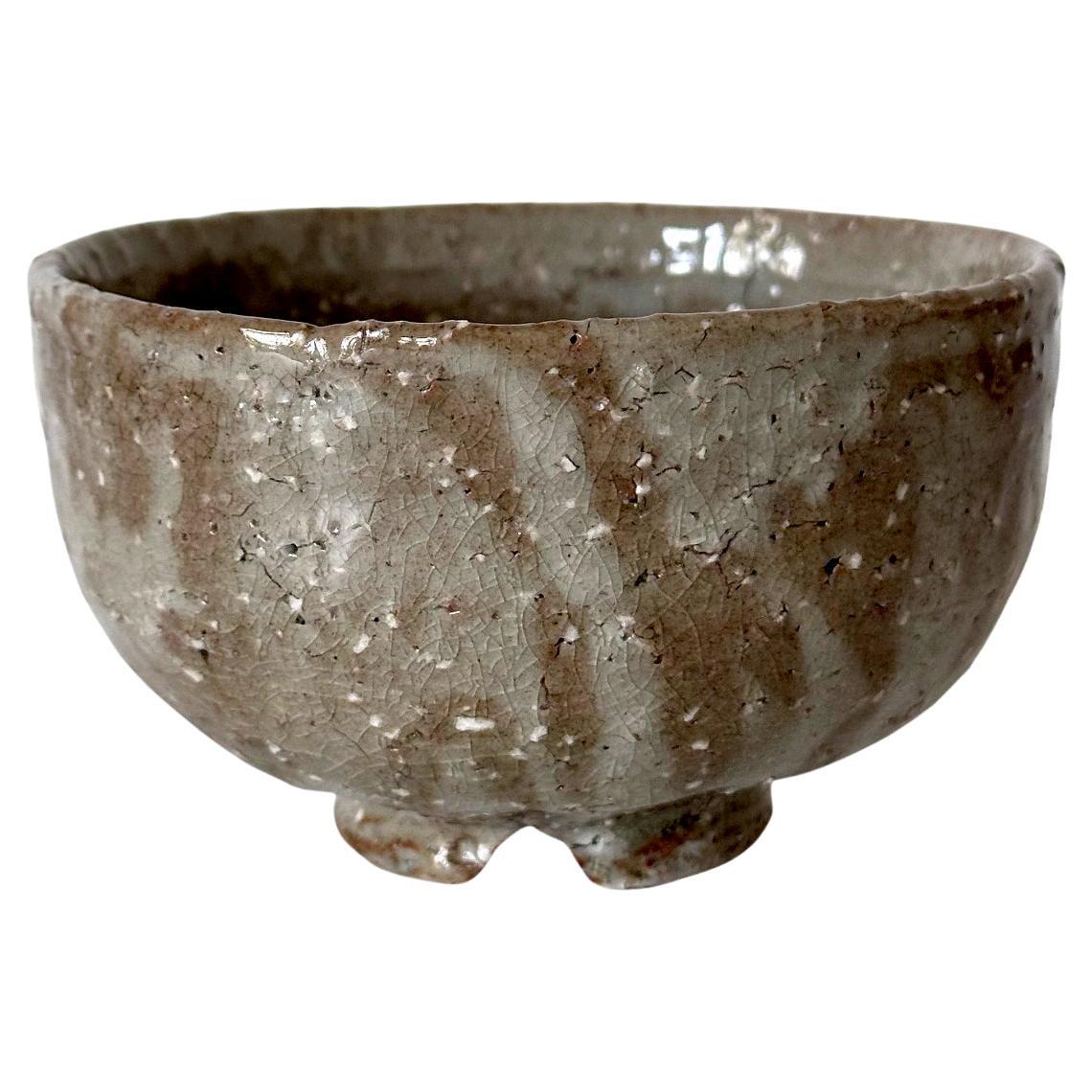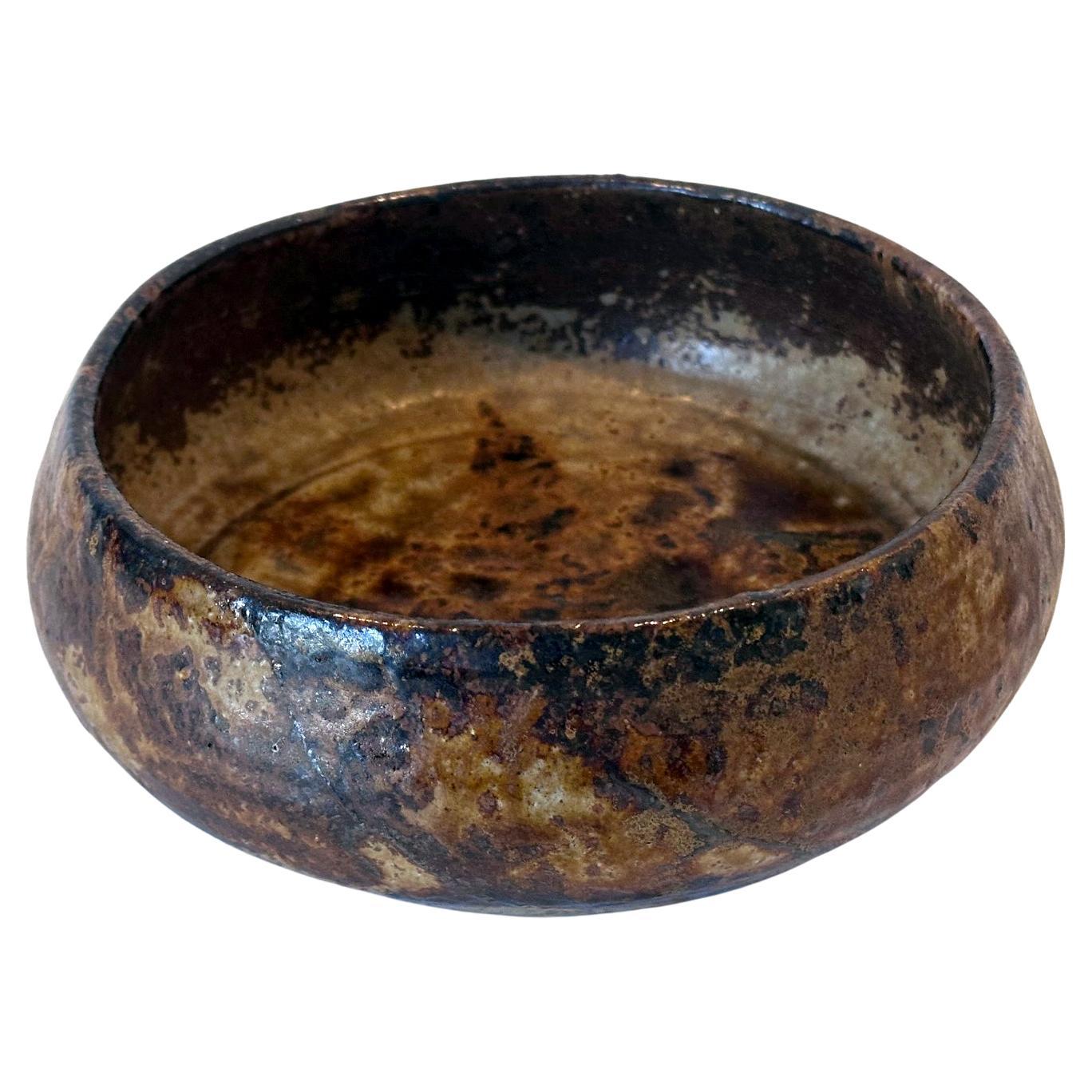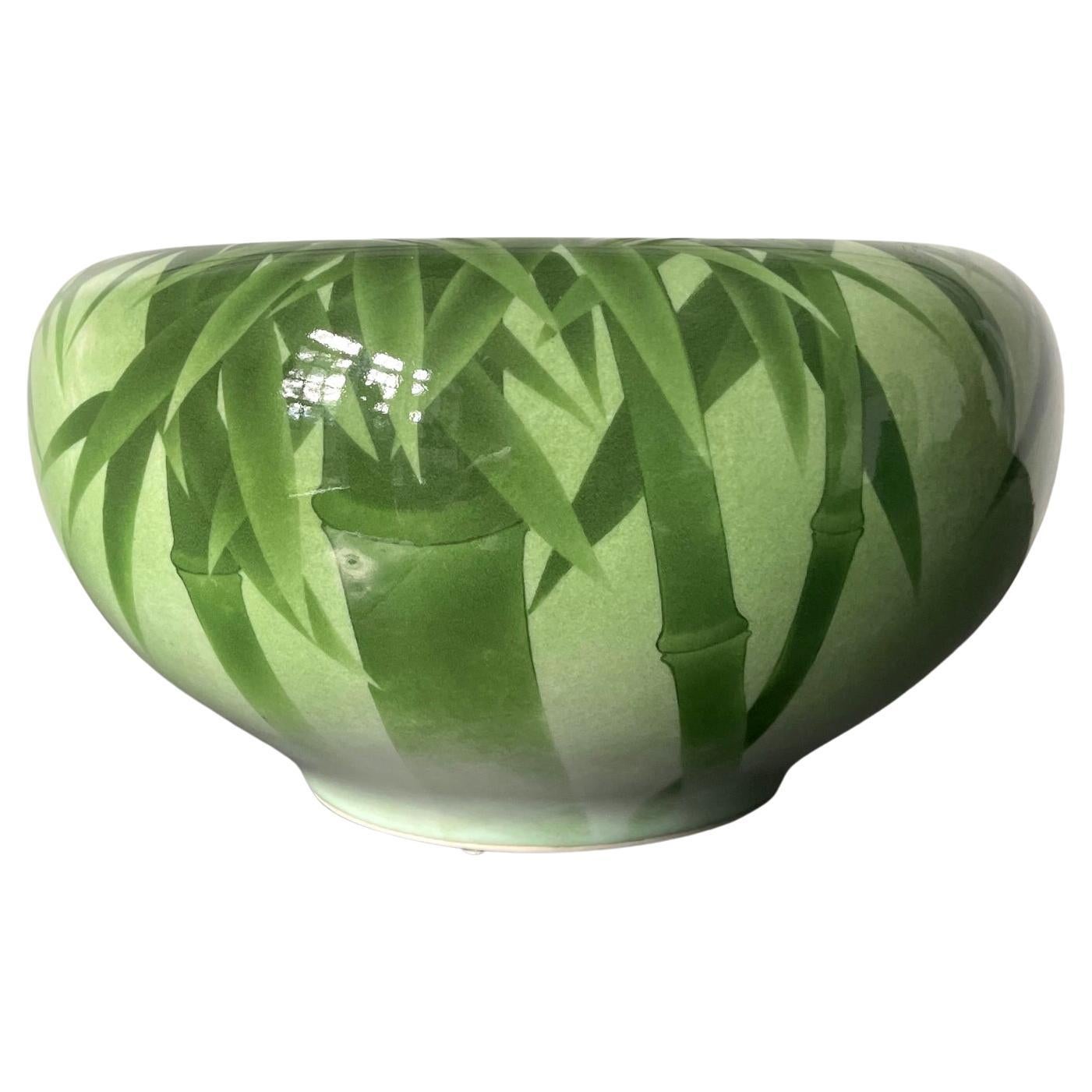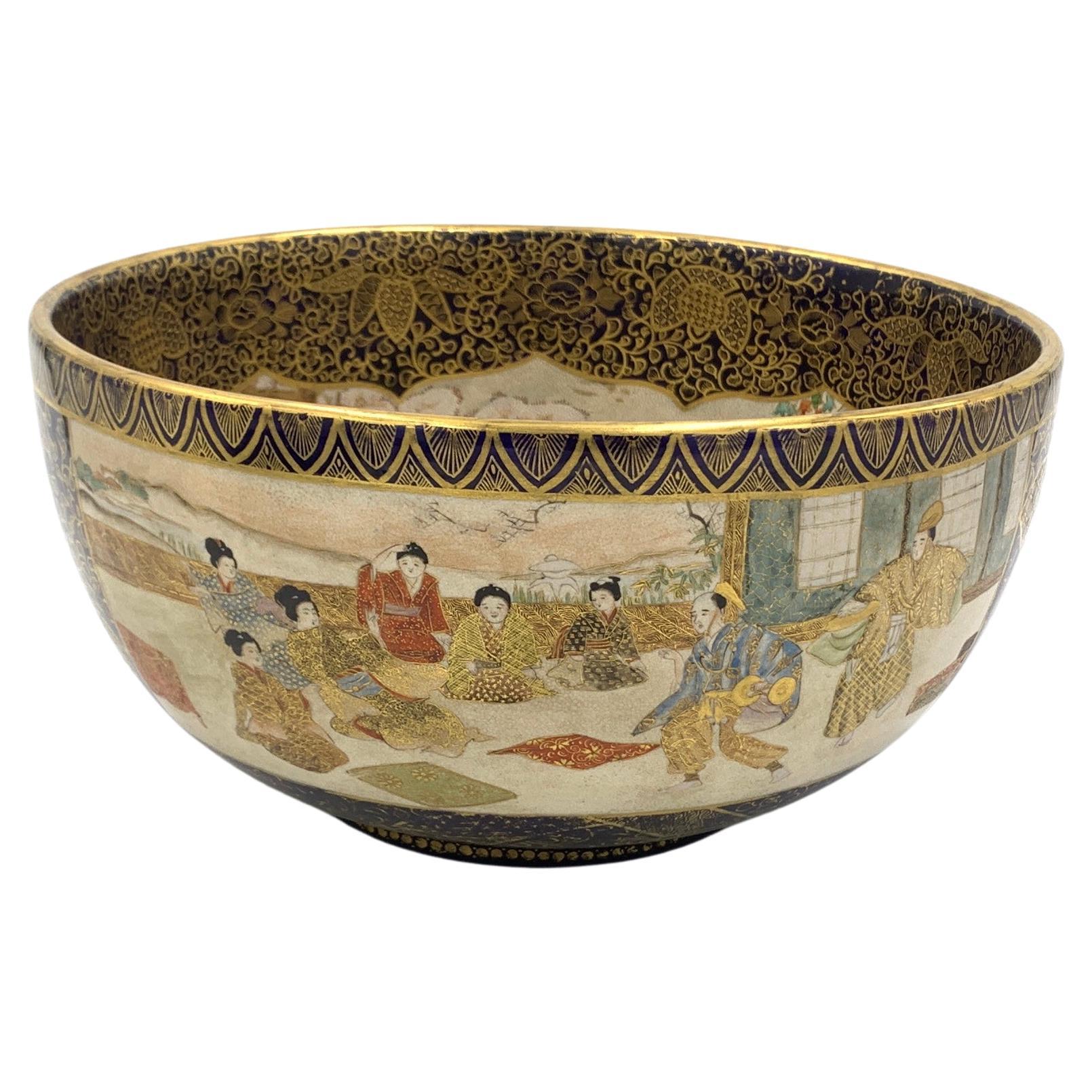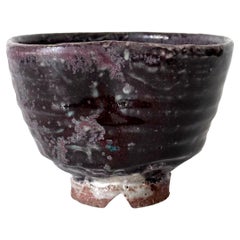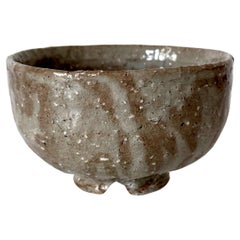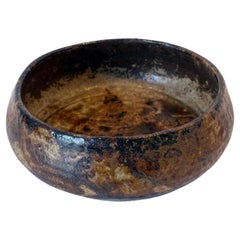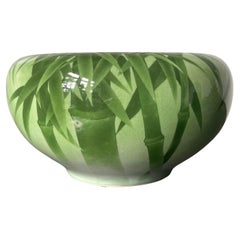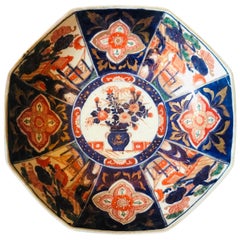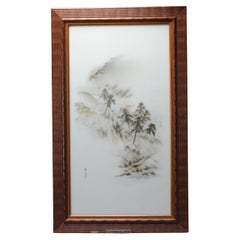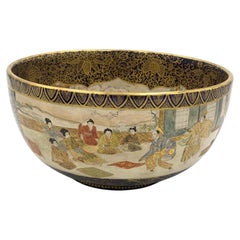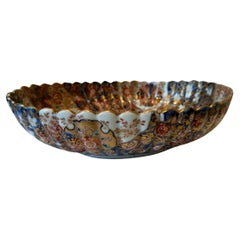Items Similar to Japanese Ceramic Bowl with Crescent Mark by Kodai-ji Kiln Meiji Period Ex-Musuem
Want more images or videos?
Request additional images or videos from the seller
1 of 13
Japanese Ceramic Bowl with Crescent Mark by Kodai-ji Kiln Meiji Period Ex-Musuem
About the Item
An unusually shaped ceramic chawan made by Kodai-ji Kiln in Kyoto circa 19th century of Meiji Period. The bowl has a rounded shape of a monk's alms bowl supported by a short foot ring, but it has a square mouth opening. The exterior features carved lines of chevron pattern. Covered completely in a coral pink glaze except the base, the bottom well of the interior has a curious mark of crescent moon in a light-yellow color. The bowl was possibly used as a Haiki (ash bowl) during tea ceremony (chado), and one can only imagine how the moon plays hide and seek in the dark green tea during the leisurely process. As the accouterments of Japanese tea ceremony is highly attuned to the seasonal change, the specific crescent design indicates that the bowl may be only used on the new moon phase of the month. The unglazed base was branded with a seal mark "Kodai-ji". The mark is associated with Rokurokudo, a ceramic maker in Kyoto that is still in business today. We can't be entirely sure when the bowl was made but it was likely in the late Meiji Period around 1900s.
The bowl was in the collection of Yale University Art Gallery and still bears a paper label 1170A as shown.
It comes with a digital copy of the museum card of its provenance and history.
About the maker:
The first-generation Rokurokudo master opened his own pottery kiln in Entoku-in Temple (a sub-temple of Kodai-ji Temple) in the Higashiyama district. He gave his pottery works the name Kodaiji-yaki. Later, the kiln was moved to Sannenzaka Street, just by the famous Kiyomizu Temple, and Rokurokudo created fine Kyo-yaki and Kiyomizu-yaki pottery works as a manufacturer throughout the Meiji, Taisho and Showa periods.
- Dimensions:Height: 2.75 in (6.99 cm)Diameter: 5.75 in (14.61 cm)
- Style:Meiji (Of the Period)
- Materials and Techniques:Ceramic,Glazed
- Place of Origin:
- Period:
- Date of Manufacture:19th century
- Condition:Wear consistent with age and use. Fine with minimal shelf wear.
- Seller Location:Atlanta, GA
- Reference Number:1stDibs: LU945044105482
About the Seller
4.9
Platinum Seller
Premium sellers with a 4.7+ rating and 24-hour response times
Established in 2006
1stDibs seller since 2010
551 sales on 1stDibs
Typical response time: <1 hour
- ShippingRetrieving quote...Shipping from: Atlanta, GA
- Return Policy
Authenticity Guarantee
In the unlikely event there’s an issue with an item’s authenticity, contact us within 1 year for a full refund. DetailsMoney-Back Guarantee
If your item is not as described, is damaged in transit, or does not arrive, contact us within 7 days for a full refund. Details24-Hour Cancellation
You have a 24-hour grace period in which to reconsider your purchase, with no questions asked.Vetted Professional Sellers
Our world-class sellers must adhere to strict standards for service and quality, maintaining the integrity of our listings.Price-Match Guarantee
If you find that a seller listed the same item for a lower price elsewhere, we’ll match it.Trusted Global Delivery
Our best-in-class carrier network provides specialized shipping options worldwide, including custom delivery.More From This Seller
View AllJapanese Gohon Glazed Tea Bowl Chawan Meiji Period Ex-Musuem
Located in Atlanta, GA
A Japanese ceramic Gohon tea bowl (Chawan) with a slightly irregular wall circa 18th century of Meiji Period. Supported by a high notched foot ring that was left unglazed, the chawan...
Category
Antique 18th Century Japanese Meiji Ceramics
Materials
Ceramic
Japanese Glazed Mino Tea Bowl Chawan Showa Period Ex-Musuem
Located in Atlanta, GA
A Japanese glazed ceramic tea bowl (chawan) in Gohon style likely made in Showa period of 20th century. Supported by a short foot ring with a notch, the bowl was made from coarse cla...
Category
Early 20th Century Japanese Meiji Ceramics
Materials
Ceramic
Japanese Glazed Stoneware Bowl by Kitaoji Rosanjin Ex-Musuem Collection
By Rosanjin Kitaoji
Located in Atlanta, GA
A stoneware round bowl with dramatic glaze made by Kitaoji Rosanjin (1883-1959) circa first half of the 20th century. The low height bowl with wide opening and swell body resembles a...
Category
Mid-20th Century Japanese Modern Ceramics
Materials
Ceramic
Japanese Ceramic Centerpiece Bowl Makuzu Kozan Meiji Period
By Makuzu Kozan
Located in Atlanta, GA
A beautiful ceramic vessel in the form of Bo, the so-called monk's alms bowl from the studio of Japanese Potter Makuzu Kozan, also known as Miyagawa Kozan (1842–1916), one of the most established and collected ceramist from Meiji Period. Born as Miyagawa Toranosuke, Kozan established his pottery studio in Yokohama circa 1870s and later became one of the appointed artists to the Japanese Imperial household. His work was exhibited in many international fairs that the Meiji government participated at the turn of the century and won many grand prizes.
Of a relatively large size, this piece was made as a decorative center piece for display. It was brilliantly decorated with underglaze paint of a green-on-green bamboo motif, using the novel technique developed by Kozan called Fuki-e (the blow painting). As a result, the bamboos appear took on a three-dimensional quality as if appearing in a mist. Known as one of the most creative ceramists, circa 1887, Kozan started experimenting with new chemical colors from the West in the format of his porcelain glaze. New colors allowed him to create underglaze design that appeared bright, smooth and glossy. To create design that is realistic and dimensional, more common in the western paintings, he was inspired by the native Japanese ink painting technique developed around 1900 by Yokoyama Taikan...
Category
Antique Early 1900s Japanese Japonisme Ceramics
Materials
Ceramic
Large Japanese Ceramic Vase by Makuzu Kozan Meiji Period
By Makuzu Kozan
Located in Atlanta, GA
A large Japanese ceramic vase by the celebrated Meiji imperial potter Makuzu Kozan (1842-1916) circa 1880-1890s. Dated to his underglaze phase post 1887 after he successfully mastered the new colors available from the west and used them to the best advantage in his work deeply rooted in Japanese aesthetics. The vase has an impressive size and was potted in the classic baluster form with an elegant proportion. The surface is decorated using a combination of techniques of low relief sculpturing...
Category
Antique Late 19th Century Japanese Meiji Ceramics
Materials
Ceramic
Rare Japanese Ceramic Glazed Bowl Makuzu Kozan Meiji Period
By Makuzu Kozan
Located in Atlanta, GA
On offer is a rare ceramic bowl with overglazed design by the famed Japanese ceramic artist Makuzu Kozan (1842-1916), circa 1906-1916. The bowl is rather unusual from the potter's repertoire with its unique glaze colors and decoration, and it likely belonged to a small series that Kozan made in and after 1906. A bowl of similar glaze and nearly identical dragon motif was recorded as a diplomatic present to the British royalty Arthur Connaught (1883-1932) when he represented King Gorge V in Japan in 1906. Other pieces, such as this bowl, were likely made with similar materials and designs afterwards.
Essentially round in form, the bowl has a generous volume with six harmonious lobes. The bottom of the interior showcases a coiled dragon in red, green and gold slithering on a cobalt blue background. The roundel shares an echoing lobed perimeter, which is further outlined by red and turquois bands and rising sun design. The exterior of the bowl features six stylized Japanese camellias...
Category
Antique Early 1900s Japanese Japonisme Ceramics
Materials
Ceramic
You May Also Like
Meiji Period Large Japanese Imari Bowl Centerpiece
By Imari Porcelain
Located in Vero Beach, FL
Meiji period large Japanese Imari bowl centerpiece
This large, distinctive, octagonal porcelain Imari bowl is painted in rich, inky blue, co...
Category
Antique 19th Century Japanese Meiji Ceramics
Materials
Porcelain
$625 Sale Price
50% Off
Antique Meiji Period Japanese Kutani Plaque with Landscape and Mark Japan 19th C
Located in Amsterdam, Noord Holland
Description
Faboulous japanese porcelain plaque. Very high quality painting of a Mountain landscape.
Marked with signature.
Conditio...
Category
Antique 19th Century Japanese Meiji Ceramics
Materials
Porcelain
$2,489 Sale Price
20% Off
Japanese Satsuma Bowl, Meiji Period
Located in London, GB
Signed, Meiji period (late 19th century), Decorated in various coloured enamels and lavish gilt on a blue ground with panels containing samurai, ladies in kimono, the interior with a...
Category
Antique Late 19th Century Japanese Ceramics
Materials
Porcelain
$2,416 Sale Price
20% Off
Japanese Early Meiji Period Porcelain Bowl, circa 1870
Located in Takarazuka, JP
Exceptional Japanese early Meiji period (circa 1870) signed Imari ribbed porcelain Bowl, extremely intricately hand-painted on both sides in cobalt blue ...
Category
Antique 1860s Japanese Meiji Ceramics
Materials
Gold
Japanese Meiji Period Satsuma Large Square Bowl Centerpiece
By Satsuma
Located in Vero Beach, FL
Japanese Meiji Period Satsuma large square bowl
Antique early Meiji Period 15" square with scalloped rim Satsuma bowl. Highly unusual and finely painted. ...
Category
Antique 19th Century Japanese Meiji Ceramics
Materials
Ceramic
$4,160 Sale Price
20% Off
Large Japanese Imari Rabbit Bowl, Meiji Period, mid 19th Century, Japan
Located in Austin, TX
An impressive and large Japanese Imari bowl with a golden spotted hare or rabbit, early Meiji Period (1864 to 1912), mid 19th century, Japan
The fantastic Imari bowl featuring a c...
Category
Antique Mid-19th Century Japanese Meiji Ceramics
Materials
Porcelain
